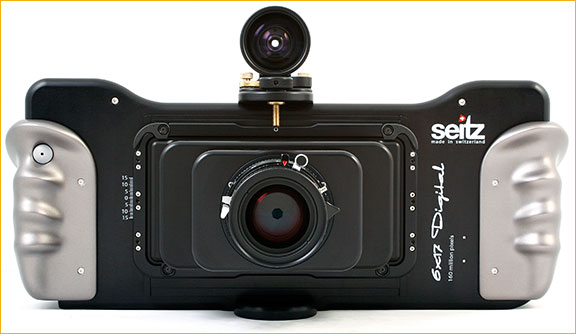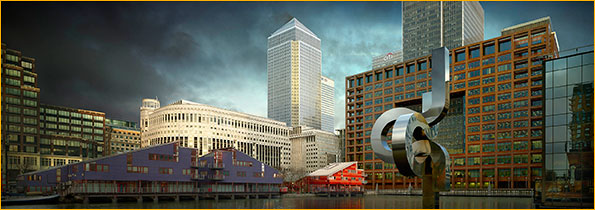By David Osborn

There isn’t another camera anywhere in the world that takes larger digital pictures than the Seitz and the 160 Megapixel files produce incredible results. In terms of scale, image definition and sheer drama, this camera brings to photography what the IMAX brings to cinema.
I was able to put Seitz’s latest through its paces after being offered a free road test by specialist supplier,Teamwork Digital, in London. My initial test shots include images of Canary Wharf and the British Library in London, and Forty Hall, a country house near my home in Enfield. They have all the detail, sharpness and vibrancy you would expect of any modern digital photographic print. The big difference is their sheer scale: here, size really does matter. The final prints measure a remarkable 44×96 inches (and bigger is also possible). They offer the viewer a near visionary experience that I think is entirely new to photography.
Of course, as photographers we have been able to print big for years but there has always been a corresponding fall-off in quality. With these prints, however, you can see every little detail – every little scrape of mortar around each brick. I feel as if I am creating a whole new reality, prints that are so life-like it is as if you are looking through a window on to the subject. As a specialist in panoramic photography, it has always been my dream to create images that fill the viewer’s field of vision – to remove the obstacle of the photograph itself from the viewer’s mind and create a picture that is so sharp and intense you feel you could be stepping into it. And this is what I think you get with the Seitz.
The Seitz is the perfect tool for this job, but it has to be paired up with both a printer and substrate of equal quality to be more than just a brilliant concept. I used an Epson 9800 printer and Innova Art’s FibaPrint® Ultra Smooth Gloss because I wanted to put together a world-beating camera with world-beating printer and paper technology.
______________________________________________________________
How it works
The Seitz D3 digital scan back creates the 6×17 panorama by scanning the back of the lens from within the body of the camera body with a 60mm Time Delay Integration (TDI) sensor. This exposes several horizontal pixels at once, rather than just a vertical line, which, says Seitz, means this scan back is a hundred times faster than any previous scanning camera or scan back equipped with a single-line RGB scanner. Under daylight conditions this should take approximately one second, though as I found out, it can take longer if less light is available. During exposure, the electronic shutter of the scan back remains open and it closes again after the image is complete. This allows a precise dark calibration and helps minimise noise, especially if you are working in low-light conditions.
Another difference with the Seitz scan back is that it registers the signal in raw – in other words, it interpolates. This has the disadvantage that no true RGB information is available for every pixel and that problems such as rainbowing or moirée may occur. On the other hand, the raw (DNG) format is much smaller than any processed TIFF file (307 MB for a full resolution 60x170mm panorama instead of 921 MB as a TIFF). It also allows full control over the raw conversion, making gamma, tone-mapping, digital filtering and other options of a raw converter available. As Seitz has adopted the open Adobe DNG raw format, the raw files can be converted conveniently in Camera Raw or in a Lightroom. It is also possible to reopen the files in the manufacturer’s Roundshot software and directly convert them into TIFF (or JPEG).
Lenses available for the Seitz 6×17 Digital include the large-format 90mm Schneider Super Angulon XL, 150mm Schneider Apo Symar L and the 250mm Schneider Tele Xenar XL lenses on Seitz lens tubes. Other options are the Linhof 617 or Fuji 617 lenses (with adaptors). All lenses can be shifted to the full extent of their image circles by shifting +/- 15mm on the camera body.

Canary Wharf – London
______________________________________________________________
In use
The camera is very easy to use and has some excellent features. Apart from the manual lens, it is operated from a PC to which it is attached by an ethernet cable. Seitz provides a Motion LE1700 tablet PC with touch screenpad, but any 32-bit Intel-based Mac or PC computer will be compatible. The laptop screen offers an appreciably bigger image of your picture than any 2.5” LCD screen and image transfer takes place in real time, so you view your picture in a second (or more). The Seitz software makes it easy to zoom in on details and work on the image before saving it.
Remote operation also minimizes the risk of you jolting and misaligning the camera after set up, which means multiple exposures in perfect registration – to the pixel! Creating flawless panoramic images that sample elements from one shot to another is very straightforward – a huge advantage.
Downsides? The camera is very robust – it’s built like a German Tiger tank! On the other hand, the kit you will find yourself carrying (scan back unit, camera body, PC, cable, lenses, spare batteries for the camera and computer, speed charger and case) easily adds up to a 60lb load (including suitable tripod) so you need to be reasonably hardy yourself!
This system is very power-hungry too: you certainly need those spare batteries (two each for camera and computer I reckon to support a full eight hour day’s work). Another issue I found was the scanning time. On a clear, moderately bright English summer day, I found images taking between 2-4 seconds to capture, so whatever Seitz say, this is not a handheld camera. Don’t expect to take phenomenal documentary-style images with this camera because it simply isn’t quick enough. This also means it’s no camera for a beginner, someone who works by shooting around a picture to discover the best shot. You need an experienced head to have composed your image ahead of taking the picture.
It generates very large files but I have a powerful, custom-built PC that dealt with them happily enough. In any case, I’m the type who work for hours in Photoshop (up to 100 hours on my Canary Wharf image, for example) to ensure that the picture is as good in all of its part as well as the whole. That file grew to about 6.5GB, which meant long printing times too. I printed in ‘fast mode’ (or bi-directional) on my 9800, which took about 1 hour and 40 minutes to complete. The alternative was ‘high quality’ printing, which took three hours – and I reckon you can’t tell the difference in the final print.
Don’t get me wrong. When I saw these images coming off the printer my reaction was – wow! I think my fellow photographers will be as stunned as I was. The prints were given their first public display on the Innova Art stand at this year’s Focus on Imaging show at the NEC (Birmingham, UK) February 22-25. Four astounding 8ft prints will be shown. Note, Seitz presented a second generation of Seitz D3 digital scan backs with many hardware improvements at Photokina 2008 and the new D3 cameras are available now. The price of the Seitz 6×17 Digital with scan back is US $38,000 US (or 42,300 Swiss Francs); lenses, computer unit and other accessories are optional.

All Photographs © David Osborn 2009 – www.britishpanoramics.com
March, 2009
______________________________________________________________
For more information please contact:
David Osborn –www.britishpanoramics.com ‚œ Tel: +44 (0)20 8882 8958
Innova Art Ltd –www.innovaart.com
Epson – www.epson.com
You May Also Enjoy...
Adobe Lightroom v.1 Tutorial
PREVIEW Learn Lightroom From The Experts Win a Nikon D300. Includes a comprehensive demonstration of the updated Lightroom v.1.1This Tutorial effectively covers the features of
Luminous Heavens
By: Jeff Ball Maybe it is hard to explain why we have the need to image anything. For me, the images inSky and Telescopewere so
